
by Tatiana Claudy
Is there a place that can compete with Versailles – and maybe win this competition? I believe it is Peterhof (“Peter’s yard” in Dutch) in Russia. Tsar Peter the Great, after visiting Versailles, was inspired to construct a similar park in Russia. He chose Peterhof which is situated about 30 km from Saint Petersburg and near the Gulf of Finland. To create a unique ensemble of parks, gardens, palaces, pavilions, and fountains, Tsar Peter invited Alexander Le Blond from France. Peterhof was initially designed as a summer residence of Peter the Great, but later was turned by Catherine the Great into one of the most famous royal summer residences in Europe.
On a warm summer day I arrived to Peterhof by bus and entered the gates near the Grand Palace, “The Russian Versailles,” designed in the Petrine Baroque style. Immediately I heard the noise of water – and a minute later I stood in awe of the Grand Cascade. Being one of the world’s largest fountains, the Grand Cascade consists of 75 fountains, 255 gilded bronze sculptures, two grottoes, and three waterfall stairs. Its design was inspired by a fountain erected near Chвteau de Marly in France. Tsar Peter, being proud of his park near the sea, ordered to build a canal from the Gulf of Finland to the Grand Palace. Thus, the terrace in front of the Grand Palace is the best spot to admire the Grand Cascade and the panorama of the Gulf of Finland. I think that Fyodor Tyutchev (Russian poet) gave one of the best descriptions of this exceptional place:
The Nature feasts beside the sea,
The fountains splash among the flowers,
The garden breathes dreamy calm. [1]
While I was admiring this view, I thought about the harmony between the nature and the art of numerous sculptors, architects, and gardeners. “Peterhof seemed to be born from the foam of the sea, as if brought to life by the command of a powerful sea king,” wrote Alexandre Benois (Russian artist). [2] I remembered his words as I saw how water drops created a mist around fountains whose forceful streams foamed and roared.
The heart of the Grand Cascade is the celebrated Samson fountain – Samson tears the lion’s mouth from which a single stream of water rises up to 21 meters. These sculptures are installed on the massive stone pedestal decorated with eight dolphins. Samson defeating the lion is an allegory of Russia’s victory over Sweden. Gilded sculptures of Samson and the lion look so naturally in the center of the Grand Cascade that it is impossible to imagine here anything else. However, Tsar Peter wanted next to his new summer residence a fountain with a sculpture of Hercules defeating the Lernaean Hydra. After Tsar Peter’s death, the Samson fountain was constructed according to the design of Carlo Rossi, an Italian architect.
I descended the stairs to enter the Lower Park and observe the Samson fountain from a different angle. There were crowds of people making photos of the Grand Cascade, so I had to squeeze into a spot from which I could have a better view at the fountain. I noticed several men and women dressed in costumes of Tsar Peter’s era – they were royalty impersonators who offered tourists to take their photos in the company of a “tsar” or a “tsarina.” Sure enough, these “royalties” enhanced the charm of this place!
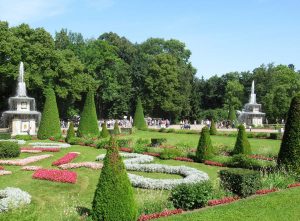 As I walked through the Lower Park, I could not stop admiring abundance of flowers. Petunias, marigolds, roses, fuchsias, and begonias were planted to create picturesque patterns on the lawns, while pyramidal trimmed little trees strengthened the likeness of this park to Versailles. Tsar Peter himself chose trees (e.g., maples and tilias) for this park and even ordered some of them abroad, for instance, apple trees from Prussia.
As I walked through the Lower Park, I could not stop admiring abundance of flowers. Petunias, marigolds, roses, fuchsias, and begonias were planted to create picturesque patterns on the lawns, while pyramidal trimmed little trees strengthened the likeness of this park to Versailles. Tsar Peter himself chose trees (e.g., maples and tilias) for this park and even ordered some of them abroad, for instance, apple trees from Prussia.
My next stop was at the Roman fountains which resemble two fountains in Rome (on the square in front of the Cathedral of St. Peter). Each of these gorgeous 10 meter tall twin-fountains consists of two flat stone bowls. Streams of water rise up, then fall on surfaces of upper and lower bowls, and finally flow into the pool at the fountain’s base. Due to this design, the Roman fountains look like being covered by the shimmering veil of water.
Gavriil Derzhavin, whom contemporaries called “the greatest living Russian poet of the 18th century,” described Peterhof as a place “where art and nature have a competition.” [3] No doubts, the Roman fountains and their lawns proved the truthfulness of these words!
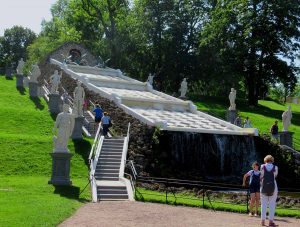 Across the Roman fountains I observed another jewel of Peterhof – the Chess Mount Cascade consisting of four slopes designed like huge chessboards. This cascade, created on a natural slope, is also called the Dragon Mountain because three dragons guard the entrance in the upper grotto. Streams of water run out of the mouths of dragons, slide along the four slopes, and finally fall like a curtain to close the lower grotto’s entrance. By the sides of the Chess Mount Cascade there are two stairways decorated by ten marble sculptures representing ancient Roman gods. Additionally, like all statues in Peterhof, these sculptures also symbolize Russia’s prosperity and sea victories.
Across the Roman fountains I observed another jewel of Peterhof – the Chess Mount Cascade consisting of four slopes designed like huge chessboards. This cascade, created on a natural slope, is also called the Dragon Mountain because three dragons guard the entrance in the upper grotto. Streams of water run out of the mouths of dragons, slide along the four slopes, and finally fall like a curtain to close the lower grotto’s entrance. By the sides of the Chess Mount Cascade there are two stairways decorated by ten marble sculptures representing ancient Roman gods. Additionally, like all statues in Peterhof, these sculptures also symbolize Russia’s prosperity and sea victories.
The square between the Roman fountains and the Chess Mount Cascade is the biggest in the park. From here depart little trains that visitors, tired from long walks, can use to have a 30-minutes long tour on the wheels. Yet I continued my journey on foot through the capital of fountains in the direction of the Gulf of Finland.
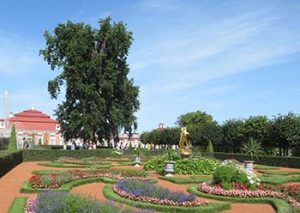 Now I approached my final destination – the Monplaisir Palace (“my pleasure” in French): Tsar Peter himself made drawings for its layout, and several architects, including Alexander Le Blond, implemented his vision. To reach the palace, I walked through a lovely garden adorned by fountains and statues. The gardeners made a little masterpiece of trimmed bushes and flowerbeds. By the way, Tsar Peter also drew the plan of this garden and chose its plants. The Monplaisir Palace, one-story long red building, does not produce an impression of the Russian Emperor’s dwelling place. However, it was the favorite palace of Tsar Peter who chose this building’s location, a few yards from the Gulf of Finland, to be able to arrive here by boat. The palace’s design is simple: two galleries adjoin the central part covered with a hipped roof. Yet this building is a fine example of architecture of the first quarter of the 18th century. No wonder that Gavriil Derzhavin praised the Monplaisir Palace in these lines:
Now I approached my final destination – the Monplaisir Palace (“my pleasure” in French): Tsar Peter himself made drawings for its layout, and several architects, including Alexander Le Blond, implemented his vision. To reach the palace, I walked through a lovely garden adorned by fountains and statues. The gardeners made a little masterpiece of trimmed bushes and flowerbeds. By the way, Tsar Peter also drew the plan of this garden and chose its plants. The Monplaisir Palace, one-story long red building, does not produce an impression of the Russian Emperor’s dwelling place. However, it was the favorite palace of Tsar Peter who chose this building’s location, a few yards from the Gulf of Finland, to be able to arrive here by boat. The palace’s design is simple: two galleries adjoin the central part covered with a hipped roof. Yet this building is a fine example of architecture of the first quarter of the 18th century. No wonder that Gavriil Derzhavin praised the Monplaisir Palace in these lines:
To learn about Eden – come and see
Tsar Peter’s charming house by the sea!” [4]
Tsar Peter opened in the Monplaisir Palace the first Russian picture gallery: he bought a collection of European paintings and used them to beautify his cherished mansion. Many rooms in the palace are also embellished with tapestries, glass and porcelain dishes, and Dutch porcelain tile. Tsar Peter often visited the Monplaisir Palace to meet with foreign ambassadors or have official assemblies of his court. According to French ambassador Kampredon, “The rooms in Monplaisir are small, but very comfortable.” [5]
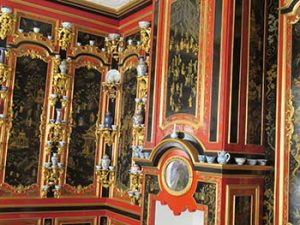 My favorite room in the palace was the Chinese Lacquer Cabinet. Unfortunately, visitors are only allowed to pass through the cabinet, without stopping there; so, I observed details of its dйcor from an adjoining room. The most important element in the cabinet’s interior decoration is eleven vertical black lacquer panels depicting scenes from the life of Chinese people. Additionally, the room is ornamented by 129 gilded shelves of different sizes and shapes (e.g. shells or leaves).
My favorite room in the palace was the Chinese Lacquer Cabinet. Unfortunately, visitors are only allowed to pass through the cabinet, without stopping there; so, I observed details of its dйcor from an adjoining room. The most important element in the cabinet’s interior decoration is eleven vertical black lacquer panels depicting scenes from the life of Chinese people. Additionally, the room is ornamented by 129 gilded shelves of different sizes and shapes (e.g. shells or leaves).
Another fascinating room, in my view, was the kitchen decorated with 3,000 pieces of tile, and each piece of tile had a picture: a landscape, seascape, or flower. The kitchen dishwasher received running water coming through the pipe from one of the fountains in front of the palace; later used water was disposed (also through pipes) into the Gulf of Finland. Such kitchen was very modern for the beginning of the 18th century!
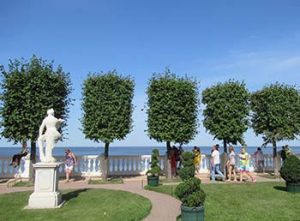 I left the palace and walked around it to come to the sea terrace. As everywhere in the parks of Peterhof, there are marble sculptures, flowers, trees, and trimmed bushes. I leaned on the white balustrade to admire the view of Saint Petersburg in the distance, the fly of seagulls, and running waves of the Gulf of Finland. After observing for a while this vast sea surface, I had an amazing feeling of peace and freedom. No wonder that Tsar Peter loved this place!
I left the palace and walked around it to come to the sea terrace. As everywhere in the parks of Peterhof, there are marble sculptures, flowers, trees, and trimmed bushes. I leaned on the white balustrade to admire the view of Saint Petersburg in the distance, the fly of seagulls, and running waves of the Gulf of Finland. After observing for a while this vast sea surface, I had an amazing feeling of peace and freedom. No wonder that Tsar Peter loved this place!
Before leaving this fantastic park, I looked back at the Grand Cascade and remembered words of Russian poet Pyotr Vyazemsky:
While Peterhof tells ancient stories,
It still remains forever young!” [6]
I hope that you enjoyed this little journey with me. Sure, there is much more to see in Peterhof because I limited my walk only to one park and one palace. So, put Peterhof on your travel list and come to discover more wonders of the world’s capital of fountains!
[1] Poets about Peterhof. Fyodor Tyutchev (translation by Tatiana Claudy)
[2] The Lower Park of Peterhof. (translation by Tatiana Claudy)
[3] Poets about Peterhof. Gavriil Derzhavin (translation by Tatiana Claudy)
[4] Poets about Peterhof. Gavriil Derzhavin (translation by Tatiana Claudy)
[5] Palaces of Peter I. Monplaisir (translation by Tatiana Claudy)
[6] Poets about Peterhof. Prince Pyotr Vyazemsky (translation by Tatiana Claudy)
If You Go:
Visas for Russia (Most foreigners need visas to visit Russia.)
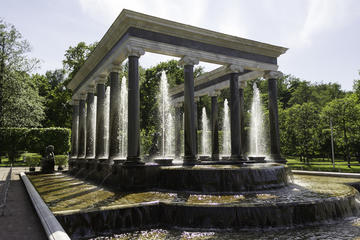
Peterhof Fountain Parks and Grand Cascade Grottos Tour
About the author:
Tatiana Claudy lives in Indiana, but she is originally from Saint Petersburg, Russia. She loves to travel and write about her journeys. Her travel articles have been published on Go Overseas and My Itchy Travel Feet sites.
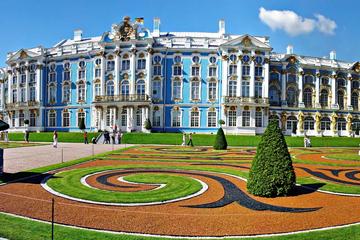
Tour of Pushkin Catherine Palace and Peterhof Grand Palace (Visas Included)
All photos by Tatiana Claudy
The Grand Cascade with the Samson fountain
The Roman fountains
The Chess Mount Cascade
The Monplaisir Palace and the Monplaisir Park
The Chinese Lacquer cabinet in the Monplaisir Palace
The view at the Gulf of Finland from the Monplaisir Palace’s terrace
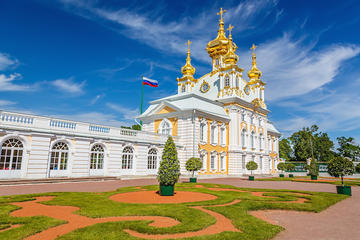
Private Half Day Excursion to Peterhof Palace from St Petersburg




Leave a Reply
You must be logged in to post a comment.